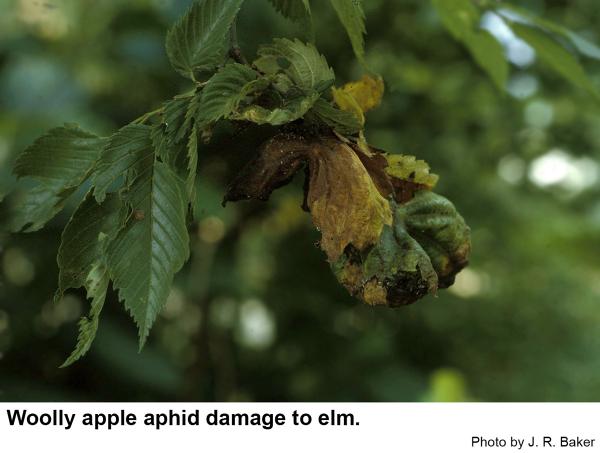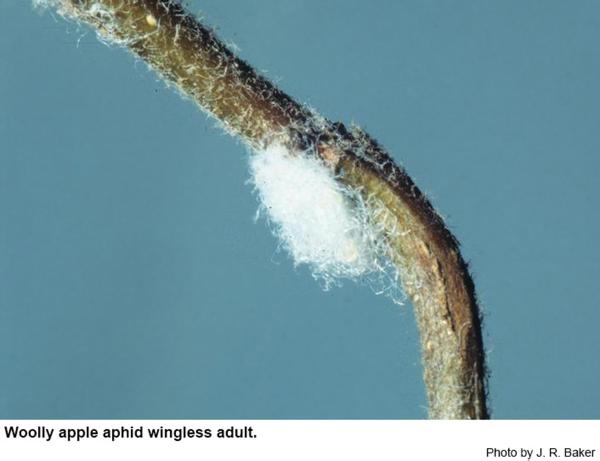Description and Biology
The woolly apple aphid, Eriosoma lanigerum, is a pest native to North America, but it has spread widely throughout apple growing regions of the world. Woolly apple aphids resemble mealybugs because they secrete a white, fluffy substance that completely covers their bodies. Woolly apple aphids congregate on the stems of crabapple and pyracantha in dense, spectacular masses. However, these pests cause most damage to the roots where they cause galls that resemble those caused by root knot nematodes. Some of the aphids migrate to the upper parts of apple, crabapple and pyracantha where they overwinter on scars, callous tissue and rough places in the bark. Some of the aphids migrate to elms where the winter is spent as eggs on the bark. In the spring these eggs hatch, and the aphids cause galls on elm leaves. The next generation on elm develops wings and flies back to apple, cotoneaster, crabapple, and pyracantha where most crawl down to the roots to feed.
Host Plants
Although the aphids cause alarm on the stems of apple, cotoneaster, crabapple, or pyracantha, woolly apple aphids cause most damage to the roots of these plants where they cause galls to form that resemble those caused by root knot nematodes. On elm, woolly apple aphids cause leaf galls inside of which they multiply.
Residential Recommendation
Because woolly apple aphids migrate from elm each spring, it is almost impossible to prevent a suseptible plant from becoming infested. Probably the best way of coping with the woolly apple aphid is to try to keep infested plants as healthy as possible (fertilize according to a soil test, prune properly, mulch, and water during prolonged dry spells). In case of a heavy infestation of woolly apple aphids, it is probably wise to treat with some sort of pesticide. Several pesticides are labeled for aphids but I recommend one of the insecticidal soaps or horticultural oils for control of aphids above ground. Because these aphids damage roots, consider applying imidachloprid granular or drench or some other systemic insecticide labeled for home landscape use.
References
- Insect and Related Pests of Shrubs. Baker, J. R. ed. 1980. NC Agricultural Extension Service publication AG-189. 199 pp.
- Woolly Apple Aphid. Beers, E. H. et at. 2019 (revised). WSU Tree Fruit
Comprehensive Tree Fruit Site. - Woolly Apple Aphid. Bessin, R. and J. Hartman. 2004 (revised). Entomology at the Univ. of Kentucky. ENTFACT-219.
- Woolly apple aphid (Eriosoma lanigerum Hausm., Hom., Aphidae) parasitism by Aphelinus mali Hal. (Hym., Aphelinidae) in relation to host stage and host colony size, shape and location. Mueller, T. F., L. H. M. Blommers and P. J. M. Mols. 1992. J. Applied Entomol. 114 (1-5): 143-154.
- Woolly Apple Aphid. Walgenbach, J. 2015. NC State Extension Publications.
- Extension Plant Pathology Publications and Factsheets
- Horticultural Science Publications
- North Carolina Agricultural Chemicals Manual
For assistance with a specific problem, contact your local N.C. Cooperative Extension Center.
This Factsheet has not been peer reviewed.
Publication date: July 13, 2013
Reviewed/Revised: Oct. 23, 2019
Recommendations for the use of agricultural chemicals are included in this publication as a convenience to the reader. The use of brand names and any mention or listing of commercial products or services in this publication does not imply endorsement by NC State University or N.C. A&T State University nor discrimination against similar products or services not mentioned. Individuals who use agricultural chemicals are responsible for ensuring that the intended use complies with current regulations and conforms to the product label. Be sure to obtain current information about usage regulations and examine a current product label before applying any chemical. For assistance, contact your local N.C. Cooperative Extension county center.
N.C. Cooperative Extension prohibits discrimination and harassment regardless of age, color, disability, family and marital status, gender identity, national origin, political beliefs, race, religion, sex (including pregnancy), sexual orientation and veteran status.





